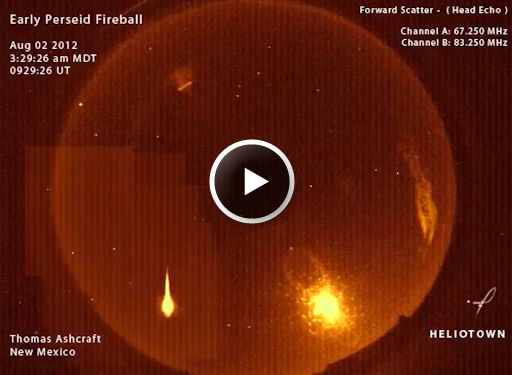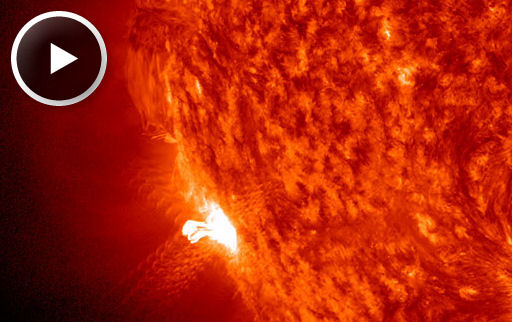Metallic photos of the sun by renowned photographer Greg Piepol bring together the best of art and science. Buy one or a whole set. They make a stellar gift. | | |
MINOR GEOMAGNETIC STORM: A minor geomagnetic storm is underway. The cause is a knot of south-pointing magnetism drifting past Earth. The IMF is opening a crack in Earth's magnetosphere, allowing solar wind to enter and fuel the storm. Aurora alerts: text, voice.
CURIOSITY & SOLAR FLARES: Mars rover Curiosity has beeen hit by multiple solar flares en route to the Red Planet, giving NASA planners an idea of what faces human astronauts in the Earth-Mars expanse. [full story]
RIPPING PERSEID: As Earth enters a broad stream of debris from Comet Swift-Tuttle, more and more Perseid meteors are appearing in the night sky. "Last night, I captured a Perseid fireball ripping through the ionosphere over New Mexico," reports amateur astronomer Thomas Ashcraft. "It was traveling pretty fast - 133,000 miles per hour!" Click to see and hear the meteoroid disintegrate:

The movie's sound track comes from Ashcraft's dual-frequency meteor radar. It works like this: Radio signals from distant VHF transmitters bounce off the meteor's ion trail. Ashcraft's antennas can pick up those reflections, which sound like ghostly echoes in the loudspeaker of his VHF receiver.
At the moment, Perseid meteor rates are low--no more than about 10 per hour. In the days ahead, however, Earth will plunge deeper into the comet's debris stream, and meteor activity will increase accordingly. Forecasters expect the shower to peak on August 12-13 with as many as 100+ meteors per hour visible from dark-sky sites. Stay tuned for Perseids.
Realtime Meteor Photo Gallery
CRACKLING SUNSPOT: Newly-numberd sunspot AR1538 is small but active. In an 18-hour period on July 30-31, it popped off more than 15 minor flares. Watch the sunspot crackle in this movie from NASA's Solar Dynamics Observatory:

The nearly-constant flaring is a sign of tension in the sunspot's magnetic field. It is not, however, a sure-fire sign that a major eruption is in the offing. On the contrary, a large number of minor flares might provide a degree of "magnetic relief" that makes a major eruption less likely.
The most likely source of a major flare today is sunspot AR1535, located more than 400,000 km north of crackling sunspot AR1538. AR1535 is relatively quiet but has a beta-gamma magnetic field that harbors energy for strong M-class eruptions.Solar flare alerts: text, voice.
Realtime Space Weather Photo Gallery
Realtime Noctilucent Cloud Photo Gallery
[previous years: 2003, 2004, 2005, 2006, 2007, 2008, 2009, 2011]

